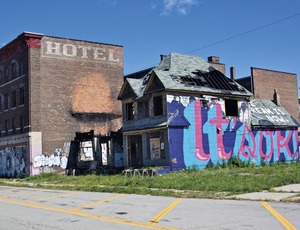
The more than 72,000 blighted structures that plague Detroit should be eliminated over the next five years so the Motor City can start its own new model, according to a public-private task force that reviewed all 377,000 parcels.
Detroit, which filed for municipal bankruptcy in July of 2013, has seen blight spread as more businesses and residents have left the city. The plan shows another 5,200 industrial, commercial and multi-family structures — or 29.7% of the total — contributing to blight.
"Unless and until we eradicate the malignant disease of blight from our city, it will be near impossible to make significant progress" on issues like education, crime and jobs, the Detroit Blight Removal Task Force wrote in the report issued May 27. The task force is chaired by Dan Gilbert, head of Quicken Loans Inc. and Rock Ventures; Glenda D. Price, Detroit Public Schools Foundation president; and Linda Smith, executive director of U-Snap-Bac.
The plan would involve demolishing more than 15,000 structures annually over the next five years. It would create a new demolition board, appointed by the mayor and the city council, to review dangerous-building demo requests.
The Detroit Land Bank Authority (DLBA) would coordinate utility disconnects so all buildings on a block would be ready for removal at the same time. It would also be in charge of paperwork and payments.
Total blight removal will cost an estimated $1.85 billion, which could be a tough sell. The city's bankruptcy exit plan calls for spending $520.3 million over the next six fiscal years, and the plan recommends earmarking at least $8 million of Community Development Block Grant funds for demolition annually. The plan calls for an annual review of all 377,000 parcels to keep track of progress.
Demolition is not new to Detroit; the city has ramped up efforts in recent months, even pushing contractors to step up the pace.
Adamo Demolition Co. will finish early on a three-week job to demo 49 houses for the DLBA. "The goal is for contractors to try to build up capacity to do a few hundred a month" to ramp up to between 3,000 and 4,500 buildings annually, said John T. Adamo Jr., CEO of the Detroit-based firm. It does both commercial and residential demolition.
That means tight scheduling, especially for buildings that contain asbestos. "At the speed they want you to do, the demo machines are coming in right behind the abatement crews," he said.
The DLBA already acts as a clearing house, assembling multi-structure packages, which Adamo said will be "much easier to manage and will save money."
The plan calls for demolition and deconstruction companies to submit combined joint-venture proposals. Requests for proposals are to be packaged by size of job and size of contractor to enable small business participation.
But Sheila Dapremont, owner of 3D Wrecking LLC, says the costs of city-required permits and bonds make it difficult to qualify for city contracts. She looks for private jobs and work in the suburbs. However, she is meeting with larger companies about acting as a subcontractor for them.
The plan also calls for establishment of a pair of recycling centers to take the demolition debris, already a practice for many demo companies.


Post a comment to this article
Report Abusive Comment